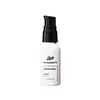What's inside
What's inside
 Key Ingredients
Key Ingredients

 Benefits
Benefits

 Concerns
Concerns

No concerns
 Ingredients Side-by-side
Ingredients Side-by-side

Water
Skin ConditioningCaprylic/Capric Triglyceride
MaskingGlycerin
HumectantMethyl Gluceth-20
HumectantCoco-Caprylate/Caprate
EmollientDimethicone
EmollientBakuchiol
AntimicrobialGlyceryl Linoleate
EmollientSimmondsia Chinensis Seed Oil
EmollientSorbitol
Humectant1,2-Hexanediol
Skin ConditioningCalcium Chloride
AstringentCaprylyl Glycol
EmollientCeteareth-20
CleansingCetearyl Alcohol
EmollientCetyl Alcohol
EmollientParfum
MaskingGlyceryl Linolenate
EmollientGlyceryl Oleate
EmollientGlyceryl Palmitate
EmollientGlyceryl Stearate
EmollientGlycine Soja Oil
EmollientHelianthus Annuus Seed Oil
EmollientHydrogenated Polyisobutene
EmollientHydroxyethyl Acrylate/Sodium Acryloyldimethyl Taurate Copolymer
Emulsion StabilisingLactic Acid
BufferingMica
Cosmetic ColorantPalmitic Acid
EmollientPEG-7 Trimethylolpropane Coconut Ether
EmulsifyingPropylene Glycol
HumectantSodium Stearate
CleansingSodium Stearoyl Glutamate
CleansingSorbitan Isostearate
EmulsifyingStearic Acid
CleansingCI 77891
Cosmetic ColorantTocopherol
AntioxidantTocopheryl Glucoside
EmollientTropolone
Skin ConditioningVanilla Tahitensis Fruit Extract
Skin ConditioningWater, Caprylic/Capric Triglyceride, Glycerin, Methyl Gluceth-20, Coco-Caprylate/Caprate, Dimethicone, Bakuchiol, Glyceryl Linoleate, Simmondsia Chinensis Seed Oil, Sorbitol, 1,2-Hexanediol, Calcium Chloride, Caprylyl Glycol, Ceteareth-20, Cetearyl Alcohol, Cetyl Alcohol, Parfum, Glyceryl Linolenate, Glyceryl Oleate, Glyceryl Palmitate, Glyceryl Stearate, Glycine Soja Oil, Helianthus Annuus Seed Oil, Hydrogenated Polyisobutene, Hydroxyethyl Acrylate/Sodium Acryloyldimethyl Taurate Copolymer, Lactic Acid, Mica, Palmitic Acid, PEG-7 Trimethylolpropane Coconut Ether, Propylene Glycol, Sodium Stearate, Sodium Stearoyl Glutamate, Sorbitan Isostearate, Stearic Acid, CI 77891, Tocopherol, Tocopheryl Glucoside, Tropolone, Vanilla Tahitensis Fruit Extract
Water
Skin ConditioningGlycerin
HumectantIsononyl Isononanoate
EmollientPEG-20 Methyl Glucose Sesquistearate
EmulsifyingPhenoxyethanol
PreservativeBakuchiol
AntimicrobialAcrylates/C10-30 Alkyl Acrylate Crosspolymer
Emulsion StabilisingChlorphenesin
AntimicrobialBisabolol
MaskingXanthan Gum
EmulsifyingPotassium Hydroxide
BufferingDisodium EDTA
Aloe Barbadensis Leaf Juice
Skin ConditioningMaltodextrin
AbsorbentPotassium Sorbate
PreservativeSodium Benzoate
MaskingWater, Glycerin, Isononyl Isononanoate, PEG-20 Methyl Glucose Sesquistearate, Phenoxyethanol, Bakuchiol, Acrylates/C10-30 Alkyl Acrylate Crosspolymer, Chlorphenesin, Bisabolol, Xanthan Gum, Potassium Hydroxide, Disodium EDTA, Aloe Barbadensis Leaf Juice, Maltodextrin, Potassium Sorbate, Sodium Benzoate
 Reviews
Reviews

Ingredients Explained
These ingredients are found in both products.
Ingredients higher up in an ingredient list are typically present in a larger amount.
Bakuchiol is a plant-derived antioxidant (it's vegan!). It is often called the replacement for retinol although it is not part of the same family.
It has similar effects as retinol: skin smoothing, reducing discoloration, and preventing wrinkles. It does not cause as much irritation as traditional retinoids.
Bakuchiol works by breaking down free radicals and stimulating collagen production in skin.
Combining bakuchiol with retinol will not have adverse side effects. Studies show using them will just boost the benefits. Bakuchiol is also found to help stabilize retinol.
While bakuchiol does not make the skin more sun sensitive, we recommend wearing SPF on a daily basis.
Read more about traditional retinol
Learn more about BakuchiolGlycerin is already naturally found in your skin. It helps moisturize and protect your skin.
A study from 2016 found glycerin to be more effective as a humectant than AHAs and hyaluronic acid.
As a humectant, it helps the skin stay hydrated by pulling moisture to your skin. The low molecular weight of glycerin allows it to pull moisture into the deeper layers of your skin.
Hydrated skin improves your skin barrier; Your skin barrier helps protect against irritants and bacteria.
Glycerin has also been found to have antimicrobial and antiviral properties. Due to these properties, glycerin is often used in wound and burn treatments.
In cosmetics, glycerin is usually derived from plants such as soybean or palm. However, it can also be sourced from animals, such as tallow or animal fat.
This ingredient is organic, colorless, odorless, and non-toxic.
Glycerin is the name for this ingredient in American English. British English uses Glycerol/Glycerine.
Learn more about GlycerinWater. It's the most common cosmetic ingredient of all. You'll usually see it at the top of ingredient lists, meaning that it makes up the largest part of the product.
So why is it so popular? Water most often acts as a solvent - this means that it helps dissolve other ingredients into the formulation.
You'll also recognize water as that liquid we all need to stay alive. If you see this, drink a glass of water. Stay hydrated!
Learn more about Water